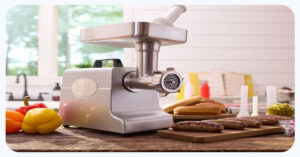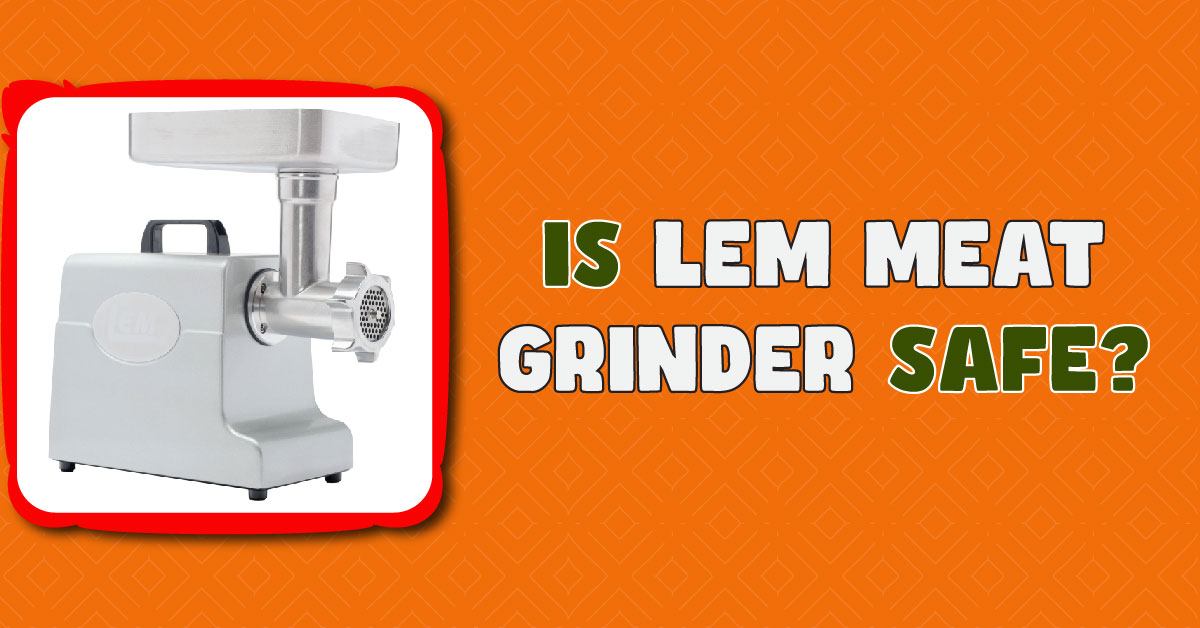If you love making fresh, high-quality ground meat at home, a LEM meat grinder is a must-have. Whether you’re a home cook, a hunter, or a small butcher, LEM grinders make the job easy. They’re built to last, with strong motors and sharp blades. I’ve used everything from the LEM 8 meat grinder for small batches to the LEM 22 meat grinder for bigger jobs. Trust me—these machines don’t quit. In this guide, I’ll share the best LEM models, my personal tips, and how to pick the right grinder for you. Let’s dive in!
Why Choose a LEM Meat Grinder?
If you’ve ever struggled with a weak, slow, or clog-prone meat grinder, you know how frustrating it can be. That’s why I swear by LEM meat grinders. They’re tough, powerful, and built for serious grinding. Whether you need a LEM 8 meat grinder for small batches or a LEM 22 meat grinder for processing large cuts, there’s a model for you.
Built to Last
LEM grinders are made with heavy-duty stainless steel. This means no rust, no flimsy plastic parts, and no overheating motors. I’ve put mine through years of grinding, and it still runs like new. If you want a reliable meat grinder that won’t quit, LEM is the way to go.
Power and Efficiency
The motors on LEM grinders are no joke. Even the LEM 3/4 HP meat grinder handles thick cuts with ease. If you’re processing wild game or big batches, models like the LEM 12 meat grinder or LEM 32 meat grinder can grind through pounds of meat in minutes. No stalling, no overheating—just smooth, powerful grinding.
Designed for Easy Use
LEM understands that grinding meat should be simple. Their grinders come with sharp blades, multiple plates, and easy-to-clean parts. I love how quickly I can switch between coarse and fine grinds. If you want a hassle-free grinding experience, LEM makes it easy.
Perfect for Home, Hunting, or Butchering
I’ve used my LEM products meat grinder for everything—making homemade burgers, grinding venison after a hunting trip, and even preparing fresh sausage. Whether you’re a home cook, a hunter, or a small butcher, LEM grinders deliver pro-level results.
Overview of LEM Meat Grinder Models
Picking the right LEM meat grinder depends on how much meat you grind and how often. LEM makes grinders for all needs, from small kitchens to heavy-duty butchering. I’ve used different models over the years, and each one has its own strengths. Let’s break them down so you can find the best fit.
LEM 8 Meat Grinder – Best for Home Use
If you grind meat now and then, the LEM 8 meat grinder is a great choice. It’s small, easy to store, and still packs a punch. It handles small batches of beef, pork, or venison with ease. I started with this model for making burgers and sausage, and it worked great. Perfect for beginners or casual use.
LEM 12 Meat Grinder – More Power, Faster Grinding
Need something stronger? The LEM 12 meat grinder has a bigger motor and grinds faster. It’s great for frequent home use or small butchering. I upgraded to this model when I started grinding more venison after hunting season. It grinds fast without clogging, which saves time.
LEM 22 Meat Grinder – Built for Large Batches
The LEM 22 meat grinder is a beast. It has a strong motor and larger plates, perfect for big batches of meat. If you process a lot of game or prep bulk meat, this model is worth it. It grinds smoothly and never slows down.
LEM 32 Meat Grinder – Heavy-Duty Commercial Power
If you grind a ton of meat or own a small butcher shop, the LEM 32 meat grinder is your best bet. It’s made for continuous use and high-volume grinding. It’s overkill for most home kitchens, but if you need serious power, this is the grinder for you.
Each model has its place. It depends on how much meat you grind and how fast you want the job done. If you’re new to grinding, LEM 8 or 12 will do the trick. If you handle big batches, LEM 22 or 32 is the way to go.
LEM Meat Grinder Parts & Maintenance
A LEM meat grinder is tough, but it needs care to last. Keeping it clean and well-oiled helps it work like new. A little effort now prevents big problems later. I’ve learned that firsthand. Here’s how to keep your grinder in top shape.

Key Parts of a LEM Meat Grinder
Knowing the parts helps you fix issues fast. Here’s a quick look:
- Blades – These cut the meat. Sharp blades make grinding easy.
- Plates – They control how fine or coarse the meat turns out.
- Auger – This pushes meat through the grinder.
- Motor – The power source that makes it all work.
- Hopper & Tray – Where you load the meat before grinding.
- Stomper – A tool that pushes meat down safely.
Each part plays a role. If one stops working, the whole machine slows down.
How to Clean Your LEM Grinder
Cleaning your grinder after each use is key. Trust me, skipping this step leads to clogs, bad smells, and rust. Here’s what to do:
- Take It Apart – Remove the blade, plate, auger, and tray.
- Wash With Warm Soapy Water – A brush helps remove meat bits.
- Dry Everything – Water causes rust, so wipe all parts well.
- Oil the Blade & Plate – A little food-safe oil keeps them rust-free.
- Store in a Dry Place – Some people store plates in a bag of rice to keep moisture out.
This routine keeps your grinder in top shape. It also makes grinding faster and easier next time.
How to Keep Your Grinder Running Smoothly
Good maintenance prevents problems. Here’s what I do:
- Sharpen the Blades Often – Dull blades make grinding hard and slow. I sharpen mine every few months.
- Check the Plates – If meat grinds unevenly, the plate may be worn out.
- Lubricate the Auger – A little grease reduces friction and helps it turn smoothly.
- Inspect the Motor – If it overheats, check for dust buildup and clean it out.
Taking care of small things prevents bigger issues later.
Fixing Common Problems
Even with care, things can go wrong. Here’s how to fix them:
- Meat Won’t Grind Well – The blade may be dull or the meat too soft. Try sharpening the blade and chilling the meat first.
- Grinder Clogs Up – Tough sinew can jam the auger. Trim fat and cut meat into small pieces before grinding.
- Motor Gets Hot – Let the machine rest between big batches. Grinding frozen meat can also stress the motor.
- Meat Tastes Weird – If you taste metal, check for rust on the blade or plate. Keep them dry and oiled.
With these tips, your LEM grinder will last for years. Take care of it, and it will take care of you.
Need new parts? LEM sells blades, plates, and more. Having extras on hand saves time when something wears out.
How to Choose the Right LEM Meat Grinder for Your Needs
Picking the right LEM meat grinder can feel overwhelming. There are different sizes, motors, and features. But don’t worry—I’ve been there, and I’ll break it down for you. Whether you grind meat occasionally or process large batches often, there’s a perfect grinder for you.
Think About How Often You’ll Use It
Are you grinding meat once in a while, or is this a regular thing? If you only grind for weekend cookouts or small meals, the LEM 8 meat grinder is perfect. It’s compact, easy to store, and handles small batches like a champ. But if you’re grinding every hunting season or making homemade sausage often, consider the LEM 12 or 22. These models have stronger motors and handle bigger loads faster.
Quick Answer: If you grind meat occasionally, go for LEM 8. For frequent use, LEM 12 or 22 is better.
What Kind of Meat Are You Grinding?
Different meats need different power levels. If you’re grinding beef, pork, or chicken, any model will work. But if you plan to process wild game like deer or elk, you’ll want more power. The LEM 22 and LEM 32 meat grinders are built for tougher meats. They can handle sinew, tendons, and large cuts without clogging.
Do You Need to Grind a Lot of Meat at Once?
If you’re making a few pounds of ground meat for burgers, a LEM 8 or 12 is plenty. But if you process large quantities like grinding an entire deer in one go then a LEM 22 or 32 will save you time. Bigger grinders have stronger motors and larger plates, so they grind faster without overheating.
Consider Your Budget
Let’s be real—price matters. LEM grinders aren’t cheap, but they last for years. If you’re just starting, the LEM 8 is affordable and does the job well. The LEM 12 is a great mid-range option for regular grinding. But if you want a lifetime investment, the LEM 22 or 32 is worth it for serious meat processing.
My Personal Recommendation
I started with the LEM 8, and it was great for small batches. But when I started grinding venison after hunting trips, I upgraded to the LEM 12—faster and more powerful. If I had to do it again, I’d go straight for the LEM 12 because it’s the best mix of power, speed, and value.
Choosing the right LEM meat grinder depends on how much you grind, what you grind, and how often.
Tips for Getting the Best Results with Your LEM Meat Grinder
Using a LEM meat grinder isn’t just about tossing meat in and hitting the switch—you need the right techniques to get smooth, consistent results. Over the years, I’ve picked up a few tricks that make grinding faster, easier, and mess-free. If you want pro-level ground meat, follow these tips.
1. Keep Everything Cold for a Cleaner Grind
One of the biggest game-changers? Cold meat grinds better. Warm meat smears and clogs the grinder, making it harder to get that perfect texture. Here’s what I do:
- Chill your meat in the freezer for about 30-45 minutes before grinding.
- Freeze the grinder parts (blade, plate, auger) for 15-30 minutes.
- Use a chilled bowl to catch the ground meat.
If your meat starts sticking or turning mushy, it’s too warm. Pop it back in the freezer for a bit!
2. Cut Meat into Small, Even Pieces
Feeding large, uneven chunks into the grinder slows things down and puts strain on the motor. Instead:
- Slice meat into 1- to 2-inch chunks before freezing.
- Trim sinew and excess fat to prevent clogging.
If you’re grinding a lot of meat, prep everything beforehand so you can grind without stopping.
3. Use the Right Grinding Plate for Texture
LEM meat grinders come with different grinding plates, and choosing the right one makes a big difference:
- Coarse plate (larger holes) – Best for chili, stew meat, or the first grind before fine grinding.
- Medium plate – Ideal for burger meat or general use.
- Fine plate (smallest holes) – Perfect for sausage or smooth-textured ground meat.
If you’re making sausage, run the meat through a coarse plate first, then a fine plate for the best texture.
4. Don’t Rush—Let the Grinder Do the Work
A LEM meat grinder is powerful, but forcing meat through too fast can cause smearing and clogging. Instead:
- Feed the meat steadily but don’t push too hard.
- Use the stomper (not your hands!) to guide the meat.
- Let the auger pull the meat in naturally.
If grinding feels tough, your blade might be dull—sharpen it or replace it for smoother results.
5. Sharpen Your Grinder Blade Regularly
A sharp blade makes all the difference. If your meat looks smeared or takes longer to grind, the blade is probably dull. Here’s how to keep it in top shape:
- Sharpen it every few months if you grind often.
- Flip the blade each time you use it to wear both sides evenly.
- Replace the blade if it looks too worn down.
Store your blade with a light coat of food-safe oil to prevent rust.
6. Clean Your Grinder Immediately After Use
Cleaning your grinder right after use prevents meat from drying and sticking. Here’s my go-to cleaning routine:
- Disassemble all parts – blade, plate, auger, and tray.
- Wash with warm, soapy water – A bottle brush helps clean small holes.
- Dry completely – Water causes rust, so towel dry and air dry.
- Lightly oil metal parts – Use food-grade mineral oil to prevent rust.
If cleaning right away isn’t possible, run a few slices of bread through the grinder to absorb leftover meat bits.
7. Grind Twice for a Perfect Blend
For the best texture, especially for burgers or sausage, grind meat twice:
- First pass: Coarse plate for an even breakdown.
- Second pass: Finer plate for smoother consistency.
Mixing different meats? Grind them together on the second pass for even distribution.
8. Use a Meat Binder for Juicier Burgers & Sausages
Lean meats like venison or turkey can turn dry. To keep them juicy:
- Add a bit of pork fat (especially for game meat).
- Mix in a meat binder like breadcrumbs, egg, or even ice-cold water.
A 70/30 lean-to-fat ratio gives the best balance of flavor and texture.
A LEM meat grinder is a powerhouse, but the secret to great ground meat is in the technique. Keep everything cold, use the right plates, and maintain your grinder for the best results. Once you dial in your process, grinding meat at home is easy, fun, and way better than store-bought.
Now it’s your turn! What’s your favorite meat to grind? Drop a comment and let’s talk meat grinding!
Final Thoughts
So, is a LEM meat grinder worth it? Absolutely. If you’re serious about grinding meat—whether for burgers, sausages, or game processing—LEM delivers durability, power, and ease of use.
I’ve put these grinders through everything: small home batches, heavy-duty venison processing, and even all-day butchering sessions. They never let me down. And trust me, once you grind your own meat, you’ll never go back to store-bought.
If you’re just starting out, the LEM #8 is a solid choice. If you want something faster and more powerful, the LEM #12 is the sweet spot. And if you’re handling big batches or processing game regularly, the LEM #22 or #32 will make your life way easier.
So, what’s next? If you’re ready to level up your meat grinding, check out the latest LEM models and grab one that fits your needs. Trust me—you won’t regret it. Happy grinding!
Have any questions or tips of your own? Drop them in the comments—I’d love to hear how you use your LEM grinder!
Read More: Best Hand Crank Meat Grinder
FAQs
Got questions about LEM meat grinders? I’ve been there. Whether you’re wondering about the best model for home use or how to keep your blades sharp, I’ve got you covered. Let’s dive into the most common questions I hear from fellow meat grinders.
Which LEM meat grinder is best for home use?
If you’re grinding meat occasionally—think burgers, sausages, or a few pounds at a time—the LEM #8 meat grinder is perfect. It’s compact, easy to store, and still packs plenty of power. But if you process larger batches often, go for the LEM #12—it’s faster and can handle more meat without overheating.
Can I use my LEM grinder for bones?
Short answer? Not really. LEM meat grinders are designed for meat and soft tissue, not hard bones. If you’re making raw pet food and need to grind soft bones (like chicken necks or wings), the larger models (#22 and #32) might handle it. But for harder bones (like beef or pork), you’ll need a specialized bone grinder.
How do I sharpen LEM grinder blades?
A dull blade makes grinding slow and frustrating. Luckily, sharpening is easy:
- Use a sharpening stone – Hold the blade at a slight angle and rub it against the stone in a circular motion.
- Flip the blade – Each time you use your grinder, flip the blade to wear both sides evenly.
- Replace if needed – If your blade is too worn down, just grab a new one. They’re cheap and make a world of difference.
My Experience: I sharpen my blade every few months and keep a spare on hand. Trust me, grinding with a dull blade is a nightmare!
Where can I buy LEM meat grinder replacement parts?
You can find replacement parts directly from LEM’s website, Amazon, or specialty butcher supply stores. Common parts like blades, plates, and augers are easy to get, and LEM’s customer service is solid if you need help finding the right part.
Is LEM better than other meat grinder brands?
From my experience? Yes. LEM grinders are built tough, with stainless steel parts and powerful motors. Compared to cheaper brands, LEM grinders last longer, grind smoother, and don’t clog as easily. If you want a grinder that’ll hold up for years, LEM is worth the investment.

